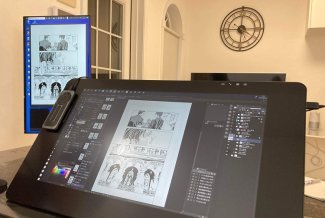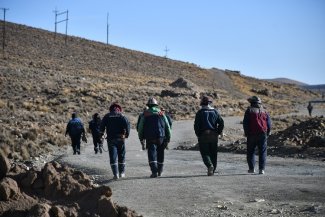Kayla Franklin, "click worker", works on her computer, in a coffee bar in Los Angeles, California.
Evan Hutchinson lives connected to his computer, day and night. At 27 years old, this Houston-based film graduate is what is known as a ‘click worker’: one of the hundreds of thousands of precarious digital workers around the world who perform dozens of micro-tasks online for companies.
Transcribing short videos, working on surveys, identifying objects on photographs, moderating content, cleaning databases or generating ‘likes’ on content from social networks. Every day, Evan seeks out new tasks by going on one of the most popular crowdwork platforms on the market: Mechanical Turk, a site created in 2005 by the e-commerce giant Amazon, which connects employers with hundreds of thousands of invisible little hands.
Sitting at home in front of his computer, staring at the screen, the young Texan scrolls through hundreds of online offers and then selects those that interest him amongst the myriad of small jobs available. A study that pays US$4 per hour (€3.50), for example asks ‘turkers’ to perform a webcam interview with a ‘computer bot’, answering questions about their health. Another aims to collect a series of data on the web page of a commercial site for just under US$3 per hour (€2.50).
Evan works between six and eight hours a day on average and generally earns between US$50 and US$100 (between €45 and €90). He does not have fixed working hours. His schedule varies according to the offers posted online. “My computer is usually on. I may work at night if a task is particularly lucrative and I am awake. Before I could perform micro-tasks non-stop for hours to earn a certain amount. Now, I have learned to take breaks,” he explains.
Young, educated workers
The International Labour Organization (ILO) has for the first time looked at the lives of these shadow workers. In the autumn of 2018, the institution published a lengthy study of 3,500 click workers working on various platforms (such as Amazon, CrowdFlower, Clickworker and Prolific) in 75 countries. Contrary to popular misconceptions that crowdworking is concentrated in emerging countries, the ILO shows that this type of work has developed strongly in the United States. According to the study, 75 per cent of the workers recruited by the Mechanical Turk platform in 2015 and 2017 were based in the United States compared to 18 per cent in India.
The popularity of crowdworking (also known as crowdsourcing) in the United States is part of a broader phenomenon: the boom of the ‘gig economy’, ‘the small-jobs economy’, via platforms like Uber or Lyft. According to a report by the US Bureau of Labor Statistics published in 2018, 16.5 million Americans work in this sector today, with the vast majority of them being ‘self-employed’ (meaning that the worker must to pay their social security contributions themselves).
Evan has worked for Mechanical Turk for nearly ten years. He joined the platform just after high school, out of curiosity, only going on it occasionally. When he left university, the young man had difficulty finding a job. This work of performing ‘micro-tasks’, which do not require special skills – apart from a little logic or basic command of the language – seamlessly turned into a source of temporary income, while waiting to find something better. “After finishing my studies, I dreamed of working in audio-visual, but in Houston, there are not many professional opportunities in this field, even when you graduate,” he says.
“Like many Americans of my generation, I was also encouraged to take out a large student loan to finance my studies, which I now have to repay. For the time being, I live at my mother’s house, because the money I earn on Amazon’s Mechanical Turk is not enough to pay for an apartment yet.”
Although they perform repetitive, low-skilled and low-paid tasks every day, most crowdworkers, like Evan, have a high level of education. According to the ILO, in 2017, 44 per cent of the US click workers working on the Amazon platform had at least a bachelor’s degree. The American turker is also young: in 2017, the average age was 35 years. The majority of micro-workers in the world were between 25 and 40 years old.
Their day-to-day work is extremely useful for the companies on these platforms, which use them to perfect their artificial intelligence tools. “They want to know how humans interact, how they deal with certain situations, depending on where they are in the world,” says Evan. “Most of the tasks we do [such as speech transcribing or image identification] cannot yet be done completely by robots.” Amazon has also called them ‘Human Intelligence Tasks’, commonly called HITs by the turkers. On a more trivial note, some even speak of being ‘meatware’, in reference to computer software or hardware, to sarcastically emphasise their robot-human condition.
In its study, the ILO has tried to understand the reasons why more and more skilled workers are today turning to crowdsourcing. The organisation explains that while some do it out of necessity (32 per cent), during a period of unemployment or to supplement their income, or because “their state of health did not allow them to perform any paid work” (10 per cent), others choose this option to have the flexibility of working from home (22 per cent), especially women.
One such case is Kayla Franklin, a single mother of three from Pennsylvania, who moved to Los Angeles a year ago. Kayla works occasionally for Appen, a company that employs ‘micro-workers’ to improve the performance of search engines of some Net giants like Facebook. “I first chose to do it so I could stay home and take care of my children,” she says. “The cost of childcare is so high in the United States that it is sometimes more cost-effective to choose teleworking to be able to take care of your family at home. Before choosing to work for Appen, my children were in childcare and I had two regular jobs, including a night job in a garage, but even so I could not make ends meet.”
Like many millennials in the US who choose to do micro-work, Kayla believes there are few benefits to being employed by a company today. “Many employers in the United States do not offer health coverage to their employees anyway. I prefer being an independent worker and being able to manage my time, my family and my passions to suit me, rather than being part of a system that imposes constraints on me, but gives me nothing,” she says.
Activist tools to defend the rights of micro-workers
Three years ago in Memphis, CJ McNelley, a former Californian carpenter, chose micro-work following health problems. He works at home, with his wife, also a turker, whom he met on one of the many self-help forums created by the community of micro-workers. “With my wife, we are part of a closed group where we share good tips and where we ensure a kind of monitoring system: as soon as interesting offers arrive on the platform, we alert the others.”
CJ opened his MTurk account seven years ago. “At first, like many people, I was lost. I had the impression that most tasks only paid US$2 an hour. Then, little by little, I got used to how the system works. Today, I earn between US$9 and US$15 an hour. This is more than the federal minimum wage which is US$7.25 (€6.50). But if I had to live on that salary in California or other US states where the cost of living has exploded in recent years, I would not be able to do it,” he explains. “I would still like a more stable future, with fewer uncertainties. Today, I can find myself spending up to 14 hours in front of my screen and I work at night to be sure to make ends meet”. According to the ILO study, digital workers in north America earned, in 2017, an average of US$4.70 (€4.10) per hour, more than in Europe or Asia but much less than the US minimum wage. Hourly averages are often pulled down by periods of unpaid work (skills trials, client searches or work completed but not approved by the client).
When problems arise, such as a refusal to pay (something nine out of ten workers have experienced, according to the ILO study), people often find themselves without recourse, because there is no union in the micro-work sector yet. CJ welcomes, however, the emergence of a number of tools like Turkopticon or TurkerReview, created by turkers or academics to try to better regulate the relations between employers and click workers.
“These are sites or tools that review the different employers on the MTurk platform, for example by indicating the hourly wage paid or the reputation, especially if they are bad payers.” Because at present, if an employer is not satisfied with the work done by a turker, they have the right to decide not to pay a worker, without the latter being able to contest this decision.
Regulating work on these platforms, be it Mechanical Turk or Uber, is one of the major challenges facing the labour movement today. “Currently, workers in digital platforms are considered freelancers and there is a lack of representation of crowdworkers in all sectors: this is due to the lack of opportunities to cooperate with their peer workers on platforms, for several reasons including dispersion on the internet and given the huge competition between them, a reluctance to exercise collective rights as it could lead to exclusion from the platform [fear of retaliation],” says a resolution by the European Trade Union Confederation. Many possible solutions are therefore under consideration, all over the world, such as the creation of a ‘fair work’ label, the improvement of the legal and legislative framework, legal action to condemn abuses, or even the creation of cooperatives and collective agreements.










